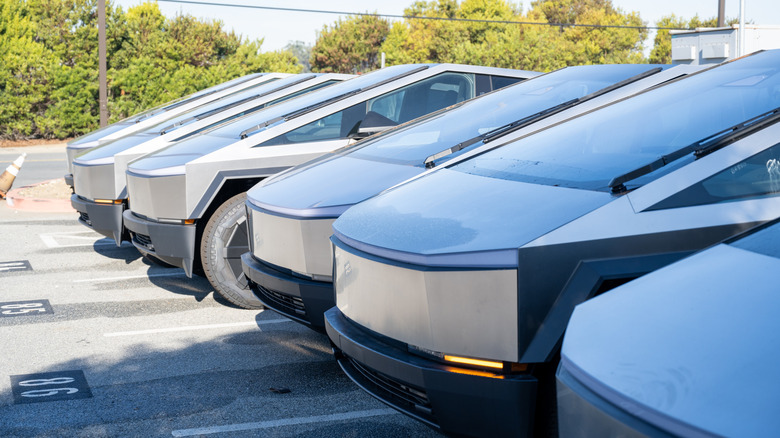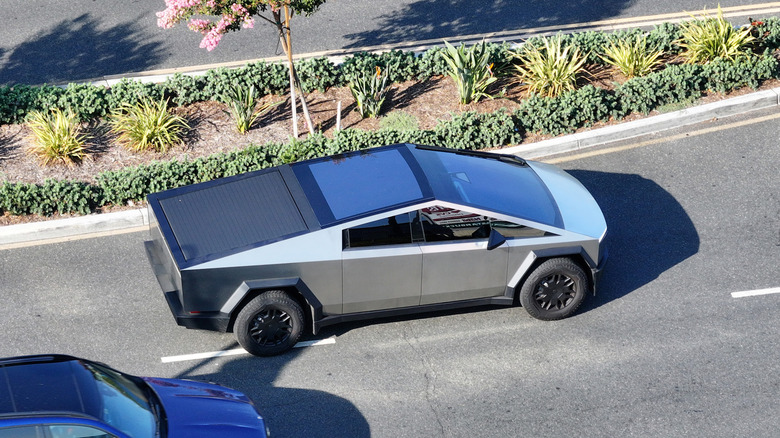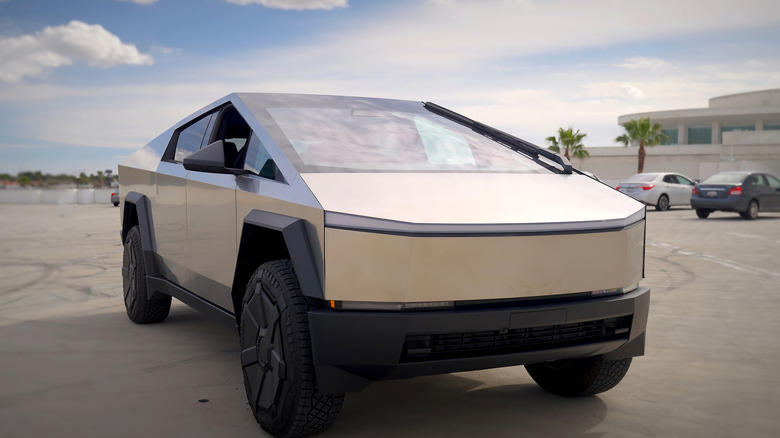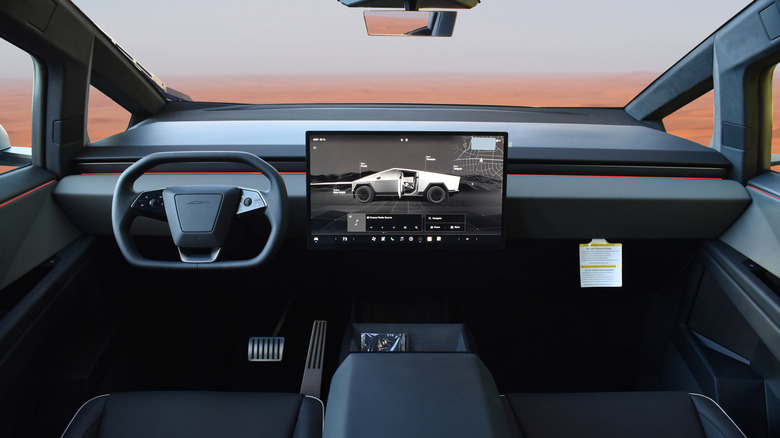The Cybertruck Is Banned In The UK, But Not For The Reason You'd Expect
More than a year after Tesla began Cybertruck deliveries in the U.S., the strange-looking electric pickup truck has only been made available in two other markets: Canada and Mexico. This is despite Tesla's presence in European markets where the EV maker has been selling its cars for several years. In the U.K., the Cybertruck is conspicuously missing from the automaker's offerings.
There is renewed discussion around the reasons for Tesla deciding against launching the model in the U.K. after an illegally driven Cybertruck was impounded by the police in the country. The pickup was found by the Bury police in the Greater Manchester area. While authorities did not reveal the identity of the driver, they did say the person was a U.K. resident and that the vehicle was seized under local laws. The Bury police clarified on Facebook that the Tesla Cybertruck is not road-legal in the U.K. and that it does not possess what is known as a "certificate of conformity."
The Facebook post went on to add that "legitimate concerns exist around the safety of other road users or pedestrians if they were involved in a collision with a Cybertruck." Now, one of the reasons popularly cited for the U.K.'s ban on the Cybertruck centers around the fact that the EV simply won't pass the country's stringent pedestrian safety directives — a topic that has received renewed attention in the U.S., as well. While there is some truth to this assertion, that alone isn't why this much-talked-about object of desire won't reach European consumers anytime soon.
Which U.K. pedestrian safety rule does the Cybertruck violate?
Many car-specific laws in the U.K. are heavily influenced by/derived from the European Union. The one directive preventing Tesla from bringing the Cybertruck to the country is the law that bans the sale of passenger vehicles that "exhibit sharp external projections." The existence of this law was revealed by none other than Tesla's VP of Vehicle engineering, Lars Maravy.
In an interview with the Dutch edition of TopGear, Maravy revealed that the sharp edges of the Cybertruck can't satisfy the European regulation (which is also followed by the U.K.) that mandates protruding parts of road-going vehicles should have a rounding of 3.2 millimeters. He went on to add how it is nigh impossible for Tesla to achieve that number with the Cybertruck's stainless steel.
This effectively means that for the unique EV pickup to legally roam the streets of the U.K. (and Europe), it would either need to be extensively redesigned or the current laws would need to be modified. We don't see either of these happening in the foreseeable future. Secondly, given that obnoxiously sized pickup trucks have been historically frowned upon across Europe, it is unlikely that Tesla would even bother bringing a redesigned Cybertruck to the U.K. despite sales of American trucks picking up pace of late.
Driving a Cybertruck in the U.K. requires a separate license category
In the U.K., licenses are granted to people based on the size and weight of the cars they drive. For someone in the country to drive the Tesla Cybertruck legally, they would likely need to acquire what is known as a category C1 driving license, which allows them to operate vehicles that weigh more than 3,500 kg (7,716 lbs).
While the heaviest iteration of the Cybertruck – the tri-motor option that weighs 6,898 lb (3,129 kg) — is under this threshold, the gross weight of the truck (which is the maximum allowed weight of the truck with passengers and cargo) puts it well above the 7,716 lbs mark. Even the lightest Cybertruck option at 8,834 lb (4,007 kg) would need its driver to acquire a C1 category license, which puts the vehicle out of reach for more than 68% of license holders in the U.K.
Secondly, for those intending to import a Cybertruck into the U.K., the process is not only convoluted but also involves something known as an Individual Vehicle Approval (IVA) test. Simply put, this test is designed for people intending to import a single or limited number of cars to the U.K. The IVA process mandates owners of the imported vehicles be subjected to an evaluation by authorities at one of the 28 IVA centers dotted across the country. Only 14 of those IVA centers are equipped to handle a vehicle as large and heavy as the Cybertruck.
The Cybertruck's steering tech is too advanced
Another hurdle for the Tesla Cybertruck in the U.K. has to do with how its steering system works. Instead of a traditional system that uses the tried and tested rack and pinion system, the Cybertruck's steering falls under the category of a "steer by wire" tech. This essentially means the Cybertruck's steering wheel doesn't have an actual physical connection with the vehicle's wheels. Instead, it uses sensors placed in the steering column that send electronic signals to the steering racks.
As far as the U.K. is concerned, current IVA regulations state that vehicles that possess steer-by-wire technology cannot be assessed by manual inspection, which impedes the approval process of the car. The same IVA document also mandates that cars traveling above 10 mph should have some degree of self-centering technology for steering wheels. There are some videos of the Cybertruck's steering wheel never returning to the center, an issue that may also lead to the Cybertruck remaining banned in the U.K.
Given the connected tech that the Cybertruck comes loaded with, that alleged issue could potentially be solved by issuing a software update. However, given that these updates are released only for vehicles in North America, Cybertrucks brought into the U.K. will not have access to future fixes and refinements. Likewise, the Cybertruck also doesn't conform to a specific IVA requirement which bans vehicles capable of traveling about 25 mph from being fitted with a toughened windscreen.



